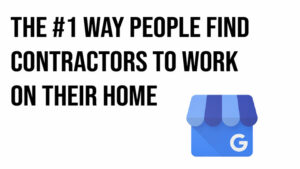As business owners, we are always thinking about making sales. I mean, we have to be, right? We typically have at least a couple of people we’re talking to that we hope will become customers soon. It’s not until we don’t have anyone to talk to and no sales in the pipeline that we start to think about lead generation. As a person of action, it can be difficult to come up with ways to find new customers. I mean, are we supposed to go door to door?
This is when the topic of marketing and lead generation comes up. But, what does lead generation actually mean? “In marketing, lead generation is the initiation of consumer interest or inquiry into products or services of a business.” – Wikipedia
This is the traditional view of lead generation from a marketing standpoint. But as a business owner, we aren’t just marketers, we are salespeople too. When you start to combine these terms and ideas into one process, we can start to think about it differently. That’s why, at Adapt Digital Solutions, we sometimes refer to lead generation as Conversation Generation when we’re working with business owners.
Generating Remodeling Leads for the Right Conversations
It’s 2020, can you believe that?. The internet has been around for over 25 years. It’s maturing. The way consumers use the internet to shop for services has advanced past the point of using it as an online phone book. As the information on the internet gets richer and more in-depth, it’s harboring more and more of the buying process for homeowners seeking home improvement services.
As a remodeler, it can be tough to keep up with all this online stuff. It’s much more comfortable to stay offline and keep doing things the old way, but that doesn’t always work. There’s a saying that goes: What got you here won’t get you there.
It means if you want to grow your business, you have to do things you haven’t done before in order to get results you haven’t had before. For a lot of remodelers, this means building their online presence and taking advantage of the scale and reach of the internet to acquire new customers and make sales.
Every sale requires a conversation. The question is how can we start more conversations? Better yet, how can we start conversations about the type of projects we want with the kind of customers we want to work with? Now we’re getting somewhere. These are the questions that will lead to business growth and success. The answer to this questions is even more important when creating the message you want to broadcast to the world. You will get what you ask for, so make sure you ask for the right thing.
When we think about lead generation as conversation generation, it becomes easier to come up with actionable ideas on how to make it happen. A homeowner can spend years thinking about and planning a remodel before they ever reach out to a remodeler. Let’s break down the buying cycle of a homeowner wanting to remodel their home so we can identify how and when to start a conversation with them.
The Buying Cycle of a Homeowner Shopping for a Home Remodel
The buying cycle for most things goes as follows:
- Problem
- Research
- Shopping
- Buying
For a kitchen remodel, the cycle might look like:
- My kitchen is dated and not functional.
- I search online for pictures and blog articles about kitchen remodeling looking for ideas for my kitchen.
- Now that I know what I want, I start searching online for a remodeler or designer. I have a little idea of how the process works, but I’m still pretty lost.
- Now that I’ve talked to some professionals, I am ready to pull the trigger on this project. I have a rough estimate and plan, and I’m ready to sign a contract.
Where is the best time to enter the conversation? Most of the time the remodeler isn’t brought into the situation until steps 3 or 4. By this time the homeowner already has set expectations and is just looking for the right person for the job. For you as the remodeler, there is a hand full of problems brought on by entering the conversation this late in the game.
The homeowner likely has a budget in mind based on what they have found online and seen on tv. As we all know, these sources are not to be trusted. Remodeling costs vary from region to region, house to house, and remodeler to remodeler. Perhaps the homeowner is under the impression that the project will take 4 weeks to complete when in reality it’s more like 4 months. For the remodeler, this means they have some work to do resetting the expectations of the homeowner. This takes time and patience. Sometimes it doesn’t work and it creates a problem later in the project.
This is why the best time to enter the conversation is in stage 2, the research stage. If we can be there to guide the homeowner through the entire process from the beginning, we can do two things.
- We can set the expectations accurately from the beginning.
- We can position ourselves as an expert and become the remodeler of choice before the customer is even ready to start shopping around. Often they will skip the shopping stage and move right into the buying because they trust the remodeler or designer who has been helping them all along.
Really, the best place to enter the conversation is stage 1, but this requires that you already have a relationship with the homeowner. We will cover this at the end of the article.
So, we’ve established that we want to enter the conversation as early as possible. How do we do that? One way is by having valuable content on our website which allows us to engage with a customer who is still in the research stage.
Attracting Customers Organically with Valuable Content
Since most consumers start their research online, having helpful resources on your website can draw homeowners in and allow you to engage with them early on. Here are just a few great content ideas you can have on your site to help your customers find their way:
- Educational resources about home improvement
- Case studies about local projects you’ve completed
- Local pricing guides
- An article about planning a project
- An article about how to find a remodeler
Topics like these examples are what your customers are looking up on Google when they’re in the research stage. Capture their attention and provide them with valuable information and insights. When you are able to build trust with your content, it’s very easy to start a conversation that can lead to a sale. If you can be the one to help your website users figure out what they want to do, they will know and trust you by the time they are ready to make the purchase.
Case studies are my favorite because it gives you a chance to show off the amazing work you’ve done. By including details such as the investment made and the time it took to complete, you are setting accurate expectations and weeding out tire-kickers and low-ballers.
It’s possible to get very creative with content, making it really fun for everyone involved. Get your employees or subcontractors together and create awesome videos featuring your projects and your company. People love to see live footage of things as they happen. Remember, you see this stuff every day, but most people never get a glimpse of what a construction site looks like. You can be the one to show them! When people share your content on Facebook, it spreads rapidly and becomes a powerful marketing tool that can really grow your business organically. Eventually, your content will show on Google and attract even more customers.
I know what you’re probably thinking. Showing up on Google takes time and money to achieve. Your SEO guy told you so. This is true, but Google is not the only way customers find your website. Often times when people are referred to your company, they will look at your website first. If they like what they see, they will stop looking for a remodeler and start thinking about their project. When they find helpful resources on your site, they will come to think of you as an expert.
Now that the homeowner has been helped by your content, we need to find a way for you to engage them directly and begin discussing their project in person or other forms of communication. There is an automated process for doing this that can save you a lot of time and effort.
Starting the Conversation
There are ways to start a conversation automatically. You can use automation to reach customers and determine if they are the right customers to take the time to talk to yourself.
Call to Action offers are strategically placed around your website that will entice the customer to get in touch with you by filling out a contact form when they’re ready. The contact form will automatically direct them to a Project Worksheet they can fill out. Upon completion, an email will be sent to you which will give you the details you need to determine if the project is worth pursuing. If it is, you can give them a call. If it’s not a project you’re interested in, you can politely decline or pass it on to a friend or colleague.
Here’s an example of the Website Worksheet I send to my new customers who are interested in a website. The information I get in this form tells me everything I need to know in order to assess whether my company is the right fit for the project. It’s very helpful when I have 10 people wanting my services and I can only choose 2 or 3.
How much time have you wasted talking to customers who weren’t serious enough or realistic enough to move forward with a project on your terms? There’s no need for this. Having a system like this in place to qualify new customers for you is the best way to free up your time to do the things that actually make you money. People that aren’t serious won’t take a few minutes to fill out the form and budgets that aren’t realistic can be addressed immediately.
As I mentioned above, the buying cycle for remodeling can be very long. A homeowner might be in the research stage for years before they decide they are ready to move forward and pursue a remodel project for their home. This is why we build automated email nurturing systems that will collect email addresses from folks who are browsing your blog articles and send them periodic emails providing valuable information about remodeling and keep your company on the top of their mind. That way, when they are finally ready to move forward, you are already the top choice of remodeler for them.
Isn’t that awesome? You can develop relationships with customers before they ever even hire you. This is the power of creating a valuable web presence that helps your target customers before you ever meet them.
When you have a complete sales system like what I describe here, you will always have multiple homeowners moving through the process at their own pace. This gives you a sense of security knowing that there are multiple customers in your sales pipeline at all times. It allows you to be more picky about who you work with, making sure that your customers and your company are the perfect fit. You will find yourself dealing with fewer problem customers as your process for automatically weeding them out gets better.
So far we’ve talked about the pre-sale conversation, but that’s not where it ends. Continuing to have a relationship with customers after the project is finished is very important for creating a long-lasting business that will continue to grow for years to come. Happy customers become life-long customers and raving fans. They spread the word and bring you new customers who are ready to hire you based on the word of those they trust. So, how can we make sure this happens?
Continuing the Conversation After the Project is Complete
When a project is complete, a lot of remodeler march forward without looking back. If the project was done well and the customer is happy, they might call back eventually when it’s time to complete another project. Hopefully, the customer will tell their friends and family about the great experience they had and the magic of Word of Mouth conversation generation will occur. This also happens when they leave online reviews. One could argue that online reviews are even more important than offline word of mouth because they last forever and can be seen by thousands of people. Google is definitely the most important place a customer can leave a review.
There are ways the remodeler can fuel the spread of word-of-mouth and make it happen more often. When you incorporate these actions into normal business functions and make sure they are performed regularly, they can bring in an enormous ROI over time.
One way to create an automated process for keeping in touch with past clients is to create an email list. Set up automatic emails that go out once every 3 or 6 months reminding them that you’re thinking about them and want to make sure they are enjoying their newly remodeled home. These emails are very similar to the ones we were talking about earlier, only they are geared towards customers we’ve already worked with instead of those we haven’t.
I’ve met remodeler that even send gifts to past clients years after they completed their project. There’s no doubt that keeping the relationship alive and the conversation going is extremely good for business. Have you ever thought of doing something like this? If not, give it a try. Think of your favorite client of all time and send them a gift to let them know you’re thinking about them. If you’re not the gifty type of person, just give them a call and let them know you’re thinking of them. By keeping yourself at the top of their mind, it’s more likely they will help you find new homeowners to have a conversation with.
You can get creative and come up with all sorts of ways to develop and maintain better relationships with your clients. This can be one of the keys to long-term business growth and is something a lot of business owners never think about.
The moral of the story is to focus on the conversations you have with your customers. They are what bring about sales, so the more conversations you can have, the better. With modern technology, it’s possible for you to automate some of this process allowing people to communicate with your business independent of you. This frees you up to do other things and allows you to scale beyond your own capabilities.
Conclusion
So, next time you are starting to wonder where your next project is going to come from, remember that it’s conversations you need to find, not leads. Thinking about leads this way will make it easier to come up with ways to make it happen. If you are getting “leads” but no conversations, you need to switch it up.
Hopefully, you will already have a system in place that is attracting customers and starting conversations automatically. Then, you will never have to worry about lead-generation again as the game becomes more about choosing the conversations you want to continue having and which ones you want to pass on to the next guy. There’s no greater feeling than passing on a project because you have a dozen better ones to choose from.
I’m in the business of getting remodelers to the point where they can pick and choose their jobs. Can I help you? Give me a call and let’s have a conversation.































